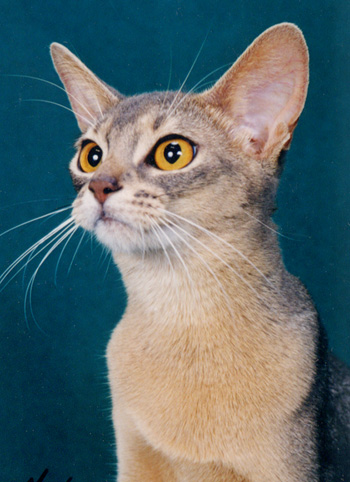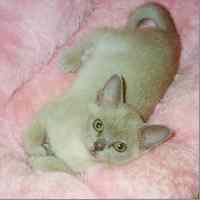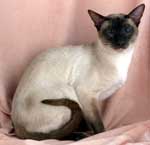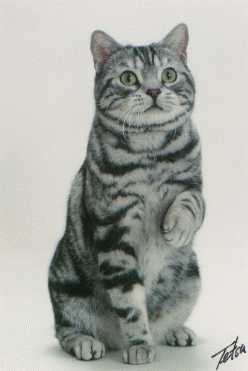
The Abyssinian is thought to be one of the oldest breeds of cat. The first Aby exhibited in a show was in England in the late 1800's. It was first mentioned historically in a book about cats published in England in 1874. Abys were imported to North America in the early 1900s and provided the foundation present day Abyssinian population in the USA. During WWII many English Abys were lost, leaving the American lines as the predominent throughout the world. Recent genetic tests seem to indicate that the breed has it's orgins in India and was brought west along early trade routes to Egypt and Abyssinia. This is how the breed came to be known as Abyssinians.
The Ruddy Abyssinian is the most popular and oldest of the accepted colors. It is described as a deep burnt-sienna, ticked with various shades of darker brown or black. This color offers nice contrast and is often described as resembling a cougar or mountain lion.
The Red or Sorrel Aby is a warm glowing red with chocolate-brown ticking. The nose leather is rosy pink and the paw pads are also pink.
The Blue Abyssinian has a warm beige under-coat ticked with various shades of slate blue ticking. There is contrast between the blue and beige which could be described as soft pastel tones. This dilute color is gaining in popularity.
Fawn Abyssinians are the newest color accepted by the CFA. It is described as a warm rose-beige coat ticked with light cocoa brown. Like the red Abyssinian, it lacks the contrast in color of the blue or ruddy, however, many find it's subtle color very appealing.
The Aby has the distinction of being considered the closest modern representative of the sacred cat of ancient Egypt. It has the same body type, shape of face, erect ears, and large eyes that are depicted in the ancient bronzes and tomb paintings. The look of the cat today is a lithe, short-haired cat of moderate size. The Aby coat is its most outstanding feature being "ticked" with three or more bands of color. It is called and Agouti coat and is what gives the Aby a wild look similar to rabbit. The coat comes in four recognized colors: ruddy (Sienna brown), red, fawn (the color of butterscotch), and blue. In many areas of the world, the Aby is called a bunny cat. The head of the Aby is a modified wedge and the face is marked with an "M" on the forehead. The eyes are rimmed in black to give this cat a pixie look that is quite enchanting. Abys have long legs and appear to stand on tiptoe.
top

The Burmese is a small shorthaired cat which is easily recognized on its golden eyes and silk shining fur. Burmese cats are extremely elegant og intelligent. They are very fond of children - almost too fond because they put up with the most incredible things - therefore it is important that you look after especially kittens who easily gets hurt from childrens rough handling. The Burmese is a very lively and active cat, who has to participate in everything that goes on in the house - from "helping" cook dinner to lending a hand (paw) reading the paper! In short your Burmese is everywhere almost all the time... Except when it sleeps - which it prefers to do under your bedcovers - or at least on the bed because Burmese cats loves heat.
The Burmese is in Europe avaliable in 10 colours, of these 6 is fully coloured: The original brown (look at top of page), chocolate (light cream chocolate-coloured), blue (steelgrey), lilac (light dove-grey), red (mandarin-coloured) og cream (very light warm red). Besides there are 4 tortieshell colours, which are mixes of the full colours with red/cream spots: Seal tortieshell (brown w. red), chocolate tortieshell (chocolate w. red), blue tortieshell (blue w. cream) and finally lilac tortieshell (lilac w. cream). Since the tortieshell pattern is genetically defined to the female cats x-chromosomes it is only females that can be torties.
Is there anyone who loves cats that has not heard of the Siamese? Blue eyes peering from an exotic, wedge shaped head and the most captivating of color patterns distinguishes this extraordinary feline. Add to this description a most affectionate nature and one readily appreciates this breed's enormous popularity.
Having been nurtured and protected within temple walls for centuries, a fact documented in art and literature, the Siamese became known to the rest of the world through the royal family of Siam. What better gift to present to a visiting dignitary than these beautiful native treasures? This is exactly the way this breed became known outside the borders of what we now call Thailand.
top

Siamese began appearing in English cat shows in the late 19th century, and in America in the early years of the 20th century. Seal point, the best known variety, was the color of these early examples. With their seal brown, almost black, points and pale fawn bodies, these beauties were striking. While chocolate points, with creamy white bodies and milk chocolate points, did appear from time to time, it was the blue point that was the next color of Siamese to gain recognition (1934). The blue point is characterized by a bluish white body with slate blue points. The chocolate point was recognized next, and, in 1955, the lilac point completed the breed. The lilac point has pinkish gray points with a white body which makes it most ethereal and delicate in color.
The long Siamese head is delineated by an absolutely straight profile, smooth wedge, large ears that complete that wedge, and deep blue, almond shaped eyes set on a slant.
This ancient breed, perhaps the oldest of all our pedigreed cats, is able to communicate like no other. The Siamese voice is legendary, and they do like to talk. They are the quintessential "people" cat, for they love to be in your lap, on your bed, at your table... in your heart!
The first cat of record with Siamese markings appeared on an old engraving discovered by a Mr. Pallas on his journey into Southern Russia between 1793 and 1794. Another is in the 'Cat-Book Poems' where drawings of cats of various colors and patterns (including Siamese, tabby, blue, etc) appeared.
In spite of these patterns, there is no clear record of Siamese cats as a breed until the 1800s. It is clearly recorded that, in 1884 the departing British Consul-General Gould was given a Siamese cat by the Siamese king as a farewell gift, and considered it as a great honor since the cat came from those bred in the palace by the royal family. Indeed, many stories exist (including the story explaining the characteristic kink in the tail of the early imported Siamese) indicating an intimate relationship between the royal family members and their cats.
A growing number of organizations recognize the traditional Siamese, and other traditional breeds, as a new appreciation develops for the health and longevity of the original bloodlines. Recent publications such as Your Purebred Kitten by Michelle Lowell (Henry Holt) have similarly recognized the true origin of the Siamese cat. The public in general is also beginning to recognize the need to avoid breeding for an extreme 'look' that, while attractive to some, has a negative impact on the animal's health. Already, most of Europe has again recognized the traditional cat and openly encourages its development, while criticizing the American practice of breeding to extremes.
top

The American Shorthair is America's own breed, whose ancestors are the cats that came to North America with the early pioneers from Europe. There are records that indicate several cats arrived on the "Mayflower." These first cats were brought along to hunt rats that ate the ship's food supplies and spread diseases to humans. For centuries, these working cats flourished along with their pioneer owners and eventually established themselves as the native North American shorthaired cat. Over the years, these cats were further appreciated for their beauty and loving natures. One brown tabby American Shorthair, in 1896, commanded the price of $2500 at the Second Annual Cat Show at Madison Square Garden. Imagine what that sum of money would be in today's dollars!
With the introduction of foreign breeds to the United States during the early part of the 20th century, the naturally pure bloodlines of these "native" shorthairs began to be diluted. Longhairs and Siamese were being allowed to run free, resulting in kittens with a variety of coat lengths, body types, colors and temperaments. Those who admired the qualities of the native shorthaired cats and wished to preserve them acquired the finest examples of the American Shorthair and began to selectively breed them. These pioneer breeders worked to perfect the patterns and colors, while retaining the strong conformation, beautiful face and sweet disposition of the breed.
Throughout the last century, the American Shorthair has made steady progress in the show ring. There have been dozens of national winning Americans including two CFA Cats of the Year and one CFA Kitten of the Year. Each of the past few years there have be well over one hundred American Shorthair grand champions, grand premiers, distinguished merit cats, regional and national winners. On the show bench, the well-muscled body, sweet expression and colorful coat are impossible to ignore. "Best Cat in Show" is often an American Shorthair.
You will find American Shorthairs to be low maintenance cats. These beautiful cats are not only lovely to look at, but are healthy, easy going and affectionate. On average, American Shorthairs live fifteen to twenty years with only annual veterinary checkups. They achieve full growth at approximately three to four years old. Males are significantly larger than females with the mature males weighing eleven to fifteen pounds and the mature females weighing eight to twelve pounds.
Known as a cat of many colors, the American Shorthair comes in over eighty different colors and patterns ranging from the striking brown patched tabby to the glistening blue-eyed white, the beautiful shaded cameo to the flashy calico van, and many colors in between. The most common American Shorthair color is the silver tabby with dense black markings set on a sterling silver background. You may have seen this handsome cat featured in television and magazine advertising or in the latest feature at your local cinema. Always consistently in the top ten most popular breeds of cat, the American Shorthair is truly a star in the feline world.
top

|


